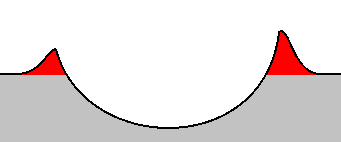Crater Rim on:
[Wikipedia]
[Google]
[Amazon]
 The rim or edge of an
The rim or edge of an
 The rim type classifications are full-rim craters, broken-rim craters, and depressions.
The rim type classifications are full-rim craters, broken-rim craters, and depressions.
 The rim or edge of an
The rim or edge of an impact crater
An impact crater is a circular depression in the surface of a solid astronomical object formed by the hypervelocity impact of a smaller object. In contrast to volcanic craters, which result from explosion or internal collapse, impact craters ...
is the part that extends above the height of the local surface, usually in a circular or elliptical pattern. In a more specific sense, the rim may refer to the circular or elliptical edge that represents the uppermost tip of this raised portion. If there is no raised portion, the rim simply refers to the inside edge of the curve where the flat surface meets the curve of the crater bottom.
Simple craters
Smaller, simple craters retain rim geometries similar to the features of many craters found on theMoon
The Moon is Earth's only natural satellite. It is the fifth largest satellite in the Solar System and the largest and most massive relative to its parent planet, with a diameter about one-quarter that of Earth (comparable to the width of ...
and the planet Mercury
Mercury commonly refers to:
* Mercury (planet), the nearest planet to the Sun
* Mercury (element), a metallic chemical element with the symbol Hg
* Mercury (mythology), a Roman god
Mercury or The Mercury may also refer to:
Companies
* Merc ...
.
Complex craters
Large craters are those with a diameter greater than 2.3 km, and are distinguished by central uplifts within the impact zone. These larger (also called “complex”) craters can form rims up to several hundred meters in height. A process to consider when determining the exact height of a crater rim is that melt may have been pushed over the crest of the initial rim from the initial impact, thereby increasing its overall height. When combined with potential weathering due to atmospheric erosion over time, determining the average height of a crater rim can be somewhat difficult. It has also been observed that the slope along the excavated interior of many craters can facilitate aspur
A spur is a metal tool designed to be worn in pairs on the heels of riding boots for the purpose of directing a horse or other animal to move forward or laterally while riding. It is usually used to refine the riding aids (commands) and to back ...
-and-gully
A gully is a landform created by running water, mass movement, or commonly a combination of both eroding sharply into soil or other relatively erodible material, typically on a hillside or in river floodplains or terraces. Gullies resemble lar ...
morphology, including mass wasting
Mass wasting, also known as mass movement, is a general term for the movement of rock or soil down slopes under the force of gravity. It differs from other processes of erosion in that the debris transported by mass wasting is not entrained in ...
events occurring due to slope instability and nearby seismic activity.
Complex crater rims observed on Earth have anywhere between 5X – 8X greater height:diameter ratio compared to those observed on the Moon, which can likely be attributed to the greater force of gravitational acceleration
In physics, gravitational acceleration is the acceleration of an object in free fall within a vacuum (and thus without experiencing drag). This is the steady gain in speed caused exclusively by the force of gravitational attraction. All bodies ...
between the two planetary bodies that collide. Additionally, crater depth and the volume of melt produced in the impact are directly related to the gravitational acceleration between the two bodies. It has been proposed that “reverse faulting and thrusting at the final crater rim sone of the main contributing factors oforming the elevated crater rim”. When an impact crater is formed on a sloped surface, the rim will form in an asymmetric profile. As the impacted surface's angle of repose increases, the crater's profile becomes more elongate.
Classification
 The rim type classifications are full-rim craters, broken-rim craters, and depressions.
The rim type classifications are full-rim craters, broken-rim craters, and depressions.
References
Impact geology Impact craters {{Crater-stub